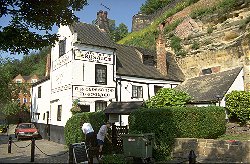Ye Olde Trip to Jerusalem
Useful Information

| Location: |
1 Brewhouse Yard, Nottingham NG1 6AD
(52.949365, -1.152627) |
| Open: |
All year daily 11-24. [2021] |
| Fee: |
free. [2021] |
| Classification: |
 Cellar Cellar
|
| Light: |
 Incandescent Incandescent
|
| Dimension: | |
| Guided tours: | self guided |
| Photography: | allowed |
| Accessibility: | no |
| Bibliography: | |
| Address: | Ye Olde Trip to Jerusalem, 1 Brewhouse Yard, Nottingham, NG1 6AD, Tel: +44-115-9473171. |
| As far as we know this information was accurate when it was published (see years in brackets), but may have changed since then. Please check rates and details directly with the companies in question if you need more recent info. |
|
History
| 1067 | castle built, probably begin of brewery. |
| 1189 | Ye olde Trip to Jerusalem established in the year that Richard the Lionheart became king, but there is no documentation to verify this date. |
| 1618 | first dated reference of the brewery. |
| 1650-1660 | current building erected. |
| 1680 | place in front of the claiff named Brew House Yard. |
| 1751 | first written mention of an inn with the name The Pilgrim in this building. |
| 1799 | first written mention of Ye olde Trip to Jerusalem. |
| 11-AUG-1952 | building listed by Historic England. |
| 1974 | archaeological dig proved conclusively that the location was the original Brewhouse. |
Description
Ye olde Trip to Jerusalem is called the oldest pub in Britain, as it claims to have been established in 1189 AD. We do not know if it is really that old, but it is definitely very impressive inside, as about half of the pub is located inside a cavern. There are half a dozen pubs claiming to be the oldest pub in Britain. All of them have a year in the 12th or 13th century when they were supposedly founded. Neither of them has proof for that claim. And each one states that his claim is true while the others are untrue. As a result the actual claim is irrelevant.
The name of the pub is obviously related to the crusades. King Richard I called Richard the Lionheart, is said to have drunken at the Trip before embarking on the Crusades. The logic conclusion is, that there actually was an inn in 1189, but a logic conclusion from a legend is still a legend. However, it was most likely originally named The Pilgrim and was first mentioned under this name in 1751. Then it was renamed Ye olde Trip to Jerusalem and was first mentioned under this name in 1799. Both names are obviously related to the crusades, but the current name is hard to understand, especially for foreigners. "Ye Olde" is pronounced "the old" and "trip" refers to a stop on a journey, rather than the journey itself. So the name actually means Historic Stopover to Jerusalem.
The reason why it is listed is the fact that most of the pub is located underground inside the castle rock. The building in front of the cliff face is just the facade. Once inside there is a room with windows and a huge bar in the rear. If you go around the bar you will find more rooms behind the bar which were dug into the rock, The most impressive room is a huge elliptical table in an elliptical niche cut into the rock, called Chimney Alcove. The ceiling is vaulted and rounded. To the right is the bigger Ward Room and the entrance to the cellars. On the left side is an underground staircase leading up to the Rock Lounge, the biggest cavern with the Ye Olde Trip Store. More steps lead up to the small museum. It’s possible to book cellar tours in advance, on which visitor can see additional cellar rooms which are not part of the pub.
The caverns were carved out of the soft sandstone during the Middle Ages and reputedly used as a brewhouse for the castle. Again there are no facts, but the logical guess is that the brewers started at or around the construction of the castle in 1067. Both workmen and guests at the castle needed beer. The caves were dug and enlarged, a building or at least wall erected in front of the caverns as a protection against bad weather. Breweries sell their beer obviously, and often they have some kind of pub where they just sell their own beer. So there is actually a high plausibility there was at least some small pub, unfortunately the is no proof. The brewery did not belong to the Castle, but passed backward and forward over time between the Priory of Lenton, The Knights of Saint John of Jerusalem and the Knights Templar. One such transfer was recorded by the City Council for the year 1618, which is in fact the first written mention of the brewery.
- See also
 Search DuckDuckGo for "Ye Olde Trip to Jerusalem"
Search DuckDuckGo for "Ye Olde Trip to Jerusalem" Google Earth Placemark
Google Earth Placemark Ye Olde Trip to Jerusalem - Wikipedia (visited: 21-AUG-2021)
Ye Olde Trip to Jerusalem - Wikipedia (visited: 21-AUG-2021) Ye Olde Trip to Jerusalem, official website (visited: 21-AUG-2021)
Ye Olde Trip to Jerusalem, official website (visited: 21-AUG-2021) Ye Olde Trip to Jerusalem - Atlas Obscura (visited: 06-MAY-2021)
Ye Olde Trip to Jerusalem - Atlas Obscura (visited: 06-MAY-2021) TRIP TO JERUSALEM PUBLIC HOUSE (visited: 22-AUG-2021)
TRIP TO JERUSALEM PUBLIC HOUSE (visited: 22-AUG-2021) Wilford Road, Brew House Yard (visited: 22-AUG-2021)
Wilford Road, Brew House Yard (visited: 22-AUG-2021)
 Index
Index Topics
Topics Hierarchical
Hierarchical Countries
Countries Maps
Maps